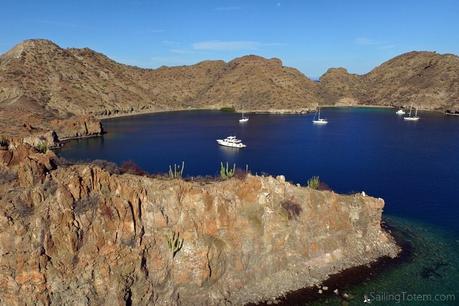
Totem cruises the Sea of Cortez; in about three weeks, we haul at the Cabrales shipyard in Puerto Peñasco, a small harbor surrounded by the Sonora desert. Typically, boats can go a few years between haulouts. So why now – didn’t we just do this in Grenada, six or seven months ago? Yes, we did, and had an unpleasant surprise. This is the backstory, and what we’ll do about it in Peñasco.
At the time we hauled out in Grenada Totem had gotten nearly three years out of the bottom paint applied in Thailand. That’s a good lifespan for ablative! We chose Grenada to repaint (a relatively safe hurricane season location, affordable rates, cruiser-friendly boatyards). Not only that, but in Grenada we had an opportunity to do a “proper” bottom job on Totem.
Prior to hauling in Grenada, we put on three bottoms on Totem in ten years, representing at least 11 coats of paints and primers and barrier coast. That’s on top of who knows how many layers we bought the Stevens 47 then called “Don’t Look Back.” Even then the hull wasn’t very smooth; over the years, accumulation of bottom paint became progressively uneven. By sand blasting the bottom back to the original barrier coat over Totem’s gelcoat bottom, we’d be able to start fresh. The crew at Grenada Marine would help us get it done right!

Totem gets hauled at Grenada Marine
Blasted surprise
To take down the old paint, a specific grade of sand is used; it’s mixed with water into a slurry that’s blasted at the bottom. This removes paint without damaging gelcoat or epoxy barrier underneath. Except what we found underneath the paint was a big surprise: there was no barrier coat. There was not even gel coat. Just bare fiberglass hull.
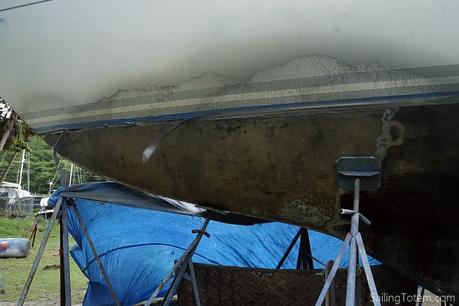
Bare fiberglass: not what we expected under the paint
The crew sandblasting stopped work to inform Jamie. I’d like to say it was to inform me, too, but I was happily internet-ing away with wifi in Grenada Marine’s lovely open-air waterfront restaurant. But this discovery… it wasn’t really good news. It wasn’t what anyone expected. The only thing to do was remove the rest of the paint, evaluate the bottom, and then decide on the next steps.
Why bare fiberglass?
We suspect Totem had a big problem with osmotic blisters somewhere in her history. Os-whaaa? Osmotic blisters are bubbles on the hull caused by a reaction between salts (from absorbed seawater) and styrene (a chemical in the fiberglass resin). This reaction causes pressure which can be great enough to push outwards between the fiberglass hull and gelcoat outer skin, creating a bubble (or, blister).
It can also happen pretty easily deeper than the surface: when fiberglass boats are made, they’re mainly constructed from heavy-duty fiberglass roving. But the outermost layer is usually thinner/lighter, to provide a smoother surface so that the last layer before gelcoat is a gentler transition to a smooth outer hull. Because that’s a thin layer of fiberglass, in bad cases of blistering this layer can be affected too: it can create voids by pushing out in that last, lightweight layer of fiberglass. (Side note: we’re not chemical / material engineers; this is just our understanding!)
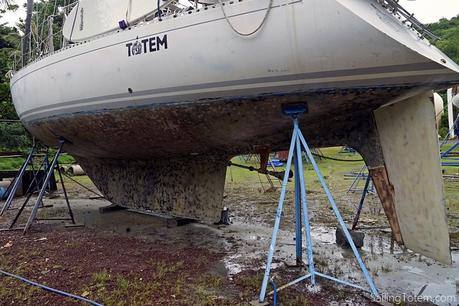
Naked hull
We suspect Totem’s problem had sufficiently bad blistering that a prior owner did what’s called a full peel. That’s when all the gelcoat is removed (peeled), and the hull is allowed to dry (hopefully) to resolve a blister problem. The bottom is then rebuilt by adding a new, thin outer layer of fiberglass and a two-part epoxy resin barrier coat over the top of that.
The crew working with us at Grenada Marine murmured approval at the fiberglass hull. Whoever did it had done a nice job, and they appreciated a good layup. The question was: would the fiberglass be wet? Or dry?
It’s a bigger problem
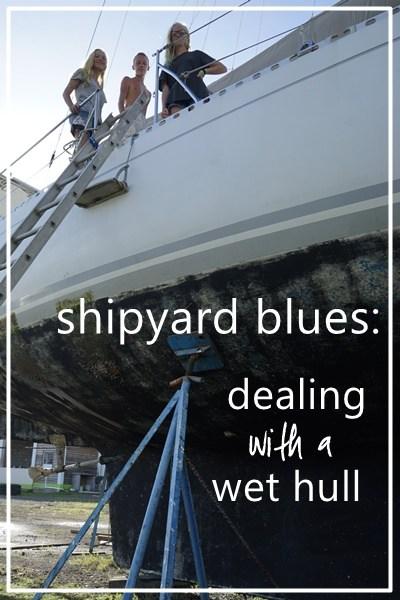
Why did it happen?
The crew may have appreciated that fine layup, but we still had a problem. Well-done fiberglass work aside, there were two unknowns in that job which lead to the moisture problem we faced.
First, we don’t know what kind of barrier coat as applied. We can tell it wasn’t a two-part epoxy resin; we’d have seen that layer that when sandblasting. We could hope that that outer layer of glass was correctly done, but we don’t know.
Second, we don’t know if moisture in the hull which caused the blisters had been dried out before the repair was made, or if there was still moisture absorbed in the hull that got covered over. What we had left is a fiberglass bottom without a gelcoat that would shown blistering from remaining moisture, so we can only speculate.
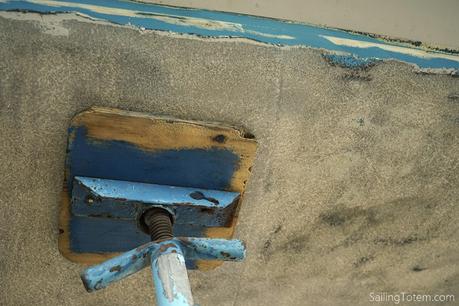
Excavating Totem’s bottom
Somewhere between these missing links of information, Totem’s bottom became a wet hull. Jamie suspects the hull wasn’t wet initially, but has happened over time under our ownership due to the problems with the earlier repairs. Why? Because for our first years of ownership we always floated high on our waterline, and in recent years, Totem has sat relatively low on her lines. OK, OK, we have accumulated trinkets on board and the kids have gotten bigger and there are probably a few more items in lockers than when we moved aboard in May 2018! But these would not add up to the mass required to sink Totem to the point where our stern end has settled down to (and even slightly below) the waterline. Most likely this water weight has slowly accumulated over time.
Now what?
We were reluctant to bury the wet hull under more paint, but had few options. The hull needs time to dry out, Grenada’s humidity and rain makes it a poor choice of location. On the other hand, we had plans to sail for the Pacific coast of Mexico. Where better than the dry desert of Baja, already our anticipated destination for hurricane season? So thin barrier coat and two thin coats of ablative bottom paint were applied: enough to get us to an ideal place for drying out a boat, the low humidity of the Sonora desert. These thin layers are already thinning, which we hope makes the job of going back to bare fiberglass for a proper dry-out an easy one.
Totem will sit on the hardstand in the desert while her crew spends a summer back in the Pacific Northwest. A periodic rinse is good and the rain there is measured in millimeters, so a periodic hose-down to help pull out impurities and styrene will be hired out in our absence. We’ll be back in the back half of October after the Annapolis Boat Show. HOPEFULLY, at that point, the hull will measure dry; then the work to put it back begins. Fairing the hull. Adding multiple coats of two-part epoxy barrier to keep water out. Starting fresh, with new bottom paint.
Grenada Marine
We may have had disappointing news during our haulout at Grenada Marine, but the crew we worked with gets high marks. Part of our decision to haul there was the full-service staff. At other boatyards, you hire in contractors associated with the yard. On one hand, that puts the choice of workers solidly in your hands. On the other, being your own project manager adds risk and time (I’d prefer deal with one point of contact the yard if there are problems, rather than a handful of different contractors). We were allowed to mix DIY work in, which helped us save money on jobs we could do, and everyone who worked on Totem impressed us.
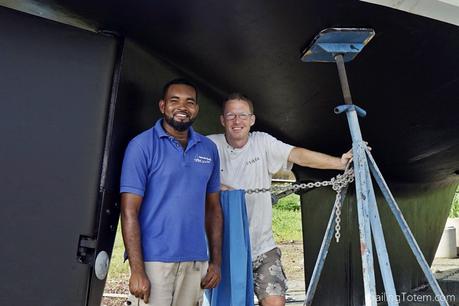
Very happy with the team at Grenada Marine! Just before splashing with a shiny bottom
More on blistering
That’s the story of why we’re hauling out again so soon. Here are a few FAQs about osmotic blistering (and water ingress).
What does it look like?
Osmotic blisters can be the size of a coin, or much bigger – especially if the thinner fiberglass layer is what’s being lifted instead of a bubble of gelcoat.
What do you do if you have blisters?
It’s a question of magnitude: the size, quantity, and depth of blisters as well as the type of hull (cored or solid). Depending on the scope of the problem, they can be dug out – dried – filled, then repainted; if there’s time you can dry the bottom further, and re-barrier coat it.
When blistering is really bad, if you can afford it: peel the (permeable) gel coat, dry out the hull, and start fresh with a new barrier coat. Just, a more effective barrier than was apparently applied to Totem!
How do you dry out?
It’s pretty convenient that we have a low-humidity desert stop ahead. Grenada would have required intervention beyond sitting on the hard to sufficiently dry out. Heat lamps, heat pads, infrared lamps, and other options are available. Glad we can just park in the desert!
How bad can it be?
Osmotic blistering is partly a cosmetic problem of unsightly pox. Mostly, it makes a boat heavier. My dear friend Pam Wall lost 1,500 pounds of water weight absorbed in the hull of her beloved Kandarik, when hauled in Portugual for the better part of a year! This is mainly a practical problem for a boat that now sits lower in the water and may be slower. It can be behind some peskier problems than just making the boat weigh more, too We’ve also heard of dampness being felt on the interior, and potentially causing problems with mold/mildew.
Can the hull integrity be compromised?
Hull thickness, and strength of the layup in the materials, make it less likely. In a cored hull, water ingress can cause more significant problems. If the outer skin is thin, the blister and moisture in it can reach core material. Presumably that’s closed cell, but can still leech and lead to larger areas of delamination. Fortunately this is pretty unusual! Bottom line: it won’t sink your boat.
Further reading
An excellent guide to boat care with good information on the why and how of osmotic blisters, and deep details for DIY fixing (because wow, can this get costly) is Don Casey’s This Old Boat.
Totem and crew are enjoying stops along the inside of Baja on the way north to Puerto Peñasco.
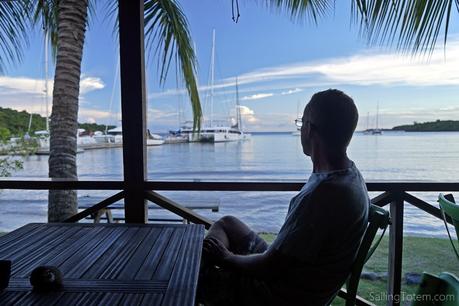
Relaxing at Grenada Marine’s restaurant at the end of the day

